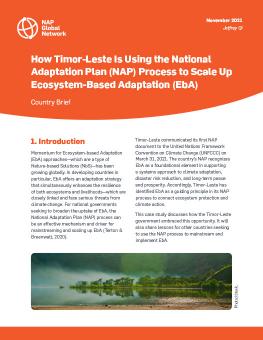
How Timor-Leste Is Using the National Adaptation Plan (NAP) Process to Scale Up Ecosystem-Based Adaptation (EbA)
This case study discusses how the Timor-Leste government has adopted Ecosystem-based adaptation as a guiding principle in its NAP process to connect ecosystem protection and climate action. It will also share lessons for other countries seeking to use the NAP process to mainstream and implement EbA.
Momentum for Ecosystem-based Adaptation (EbA) approaches—which are a type of Nature-based Solutions (NbS)—has been growing globally. In developing countries in particular, EbA offers an adaptation strategy that simultaneously enhances the resilience of both ecosystems and livelihoods—which are closely linked and face serious threats from climate change. For national governments seeking to broaden the uptake of EbA, the National Adaptation Plan (NAP) process can be an effective mechanism and driver for mainstreaming and scaling up EbA.
Timor-Leste communicated its first NAP document to the United Nations Framework Convention on Climate Change (UNFCCC) on March 31, 2021. The country’s NAP recognizes EbA as a foundational element in supporting a systems approach to climate adaptation, disaster risk reduction, and long-term peace and prosperity. Accordingly, Timor-Leste has identified Eba as a guiding principle in its NAP process to connect ecosystem protection and climate action.
This case study discusses how the Timor-Leste government embraced this opportunity. It will also share lessons for other countries seeking to use the NAP process to mainstream and implement EbA.
Participating experts
You might also be interested in
The Coral Gardeners of Saint Lucia: Local heroes against coral bleaching
Coral gardeners in Saint Lucia are working together to save reefs from the devastating effects of climate change through a flagship project under the island's National Adaptation Plan (NAP).
IISD Welcomes New Deal on Global Biodiversity Framework
IISD congratulates the Parties to the Convention on Biological Diversity (CBD) for adopting the Kunming-Montreal Global Biodiversity Framework, which will guide work within and outside the UN system on tackling biodiversity loss and help lay the groundwork towards the CBD’s vision of living in harmony with nature by 2050.
IISD Annual Report 2023–2024
While IISD's reputation as a convenor, a trusted thought leader, and a go-to source on key issues within the sustainable development field is stronger than ever, the work happening outside the spotlight is just as valuable.
How to Make Nature-Based Solutions for Adaptation Work for Everyone
Effective nature-based solutions (NbS) for adaptation start with integrated climate risk assessments. These take-aways will help practitioners plan for inclusive and sustainable NbS.